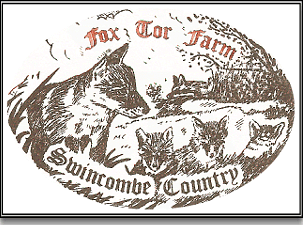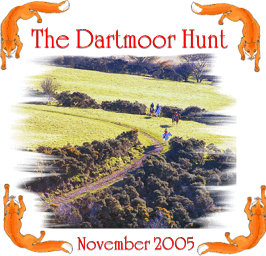
When out traipsing the moor there is nothing more evocative than to spot a fox loping across the heather or slinking amongst the clitters. On many occasions I have watched the wily animal on Dartmoor and have come to learn how at home it is on the moors. A couple of times I have seen ‘Old Charlie’ being pursued by the hounds although the fox did not seem that concerned in fact nonchalant would be a better descriptive. The animal led its pursuers into a heavy clitter or rock field then calmly trotted off behind a tor only to reappear on the other side and lope off in exactly the same direction as it had first been chased. The dogs meanwhile completely lost the scent in the clitter and did not spot ‘Old Charlie’ going back down hill who having reached the hill crest stopped and watched the hounds for a few seconds and then disappeared.
In the early 1950’s it was estimated that the fox population on Dartmoor was about three to four animals per square mile, in some areas this would rise to around 10 in March and the decline over the year due to loss and migration. This would have given a total population of around 1,277.5 (365 square miles x 3.5 average foxes (3 + 4 ÷ 2)) at the lowest estimate. Recent surveys have suggested that nationwide the numbers have not changed drastically in the past 20 years and put the national population at between 240 – 250,000. The hunting ban during the 2001 Foot and Mouth outbreak may have increases numbers slightly but again a national survey by the Mammal Society suggests it didn’t.
It was always said that the moorland foxes tended to be distinguishable from their lowland relatives by the fact that they were larger, longer legged and had darker fur but this does not apply on Dartmoor. There could be credence in the theory that at one time the moor foxes had a greyer coat and this has been affirmed by past fox hunters. However it is thought that these foxes have diminished in numbers leaving just the normal fox on the moor. In the early 1800’s there is a tradition that a man called John Bulteel released a number of French and English foxes onto the moor around Widecombe-in-the-Moor. They must have quickly established themselves because the farmers and landowners soon employed Tom French to eradicate them. It was thought that the French foxes bred with the local ones and eventually the foxes of the southern moor became smaller and redder than those of the northern moor, the southern moor foxes were often known as ‘French Foxes’. There is also a tradition that in 1910 a huntsman employed by the Dartmoor Hunt released a number of Scottish foxes on the moor, it was said they could “nearly run the hounds off their legs.” Other local names used for the moor fox was ‘Dartmoor Hectors’ and ‘Broadbury Tigers’, both terms stem from northern Dartmoor.
The vixen is receptive for mating for about three days and then around 51 days later the cubs are born usually in litters of anything up to 6 cubs. At four weeks of age the cubs emerge from the den which is normally between May and June when they can be seen playing near the earth.
The Dartmoor fox lives on a variety of foods that include rabbits, voles, mice, insects including beetles and moths, worms, snails, ground nesting birds such as the lark and Pipit and lambs. It is said that the inability of Red Grouse to establish themselves is due to fox predation. As with any fox the moor foxes will take domestic fowl when the opportunity arises. There is also evidence in dung samples found on the moor that the foxes will also eat whortleberries, blackberries and rowan berries when they are in season.
The foxes tend to live out in the open on the high moor and will often be found in the dense rock fields and clitters where they make their homes. There are several of these old ‘rock dens’ recorded by way of place-names such as Fox tor, Vixen tor, Foxes Holt, Foxes Yard, Foxholes and above Piles Copse, the sinister sounding Dungeon, all were renown for harbouring foxes.

Fox Tor Farm letterbox stamp
The first evidence for foxes on Dartmoor comes from the Buckfastleigh bone cave, here fox bones have been found in an archaeological context dating back 100,000 years. Mr Bray recorded seeing the footprints of a fox in the muddy peat at Cranmere Pool in 1802 which considering the terrain was quite a way into the moor for a fox. In Dartmoor superstition it was always though an omen of good luck to spot a single fox, however if several were seen together then that was considered to portend bad luck. If a fox was seen near a house then that foretold of an impending disaster or death. It was thought to be fatal if a fox ever bit a human which could stem back to the fear of rabies. Another moorland belief is that the fox will de-flea itself by holding a twig in its mouth and then walk backwards into a stream or pond. The fleas are said to move further up the fox as the water forces them further and further until they all congregate on the twig at which point the fox will release the twig and it and his fleas float off downstream.In the north of the moor there was a belief that the foxes held the souls of good and decent departed humans.Early folklore suggests that the fox was the Devil’s spy and anywhere that harboured them was considered to be an evil place held in the power of Satan, this could explain how the ‘Dungeon’ got its name as this was a spot noted for its fox dens.It was also considered unlucky to think of a fox whilst cutting ones fingernails, probably because any distraction would result in bloody fingers.The tongue of a fox was thought to have healing properties in so much they had a strong ‘drawing’ power to remove thorns, splinters and needles. Many falsely believed the foxglove or ‘cowflop‘ to be associated with foxes but the name foxglove derives from ‘folksglove’ pertaining to the glove of the fairy folk. Before organised fox hunting established itself in the 18th century, Church Warden accounts show that fess of between 5 and 10 shillings were paid for killing foxes. During the 1930’s there were several fox farms on the edges of Dartmoor, here silver foxes were bred for their fur. Once such a farm was the Peregrine Fur Farm located near Moretonhampstead, this and all the others have now closed.
It will be interesting to see what happens to the Dartmoor foxes now hunting has been officially banned. In theory their numbers should increase but in practice they may well decline. Previously there was a specified season for fox hunting but now any fox hunt can take place all year round providing they are hunting for other prey. There will also be a greater tendency for livestock farmers to shoot, snare or poison the foxes which will mean a lot slower and painful death.
During a recent visit to Wheal Betsy on a crisp winter’s morning I met with the fox hounds and it is interesting to see that they are only hunting with a few dogs which presumably falls within the law. So, it is nice to see that an old Dartmoor tradition has not been lost in the mists of Governmental legislation.

 Legendary Dartmoor The many aspects past and present of Dartmoor
Legendary Dartmoor The many aspects past and present of Dartmoor


Hi
We are staying in Dartmoor and have just seen an injiured fox , a beautiful animal , but he is limping . He is in the grounds of Gidleigh Park . We are in a wooden cottage in the grounds . We are going to tweet about it as well . But thought it worth messaging you as well , with your knowledge we hoped you might know who to contact .
Very best wishes
Hi, it’s probably best to contact the hotel and ask them to get in touch with the RSPA
Interesting to come across this. Thanks for this write up. Greetings from Utah, USA.